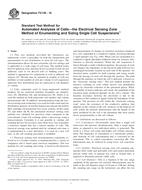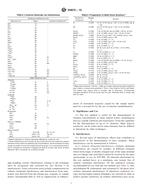1.1 This test method covers the determination of particle size distribution of advanced ceramic powders. Experience has shown that this test method is satisfactory for the analysis of silicon carbide, silicon nitride, and zirconium oxide in the size range of 0.1 up to 50 µm.
1.1.1 However, the relationship between size and sedimentation velocity used in this test method assumes that particles sediment within the laminar flow regime. It is generally accepted that particles sedimenting with a Reynolds number of 0.3 or less will do so under conditions of laminar flow with negligible error. Particle size distribution analysis for particles settling with a larger Reynolds number may be incorrect due to turbulent flow. Some materials covered by this test method may settle in water with a Reynolds number greater than 0.3 if large particles are present. The user of this test method should calculate the Reynolds number of the largest particle expected to be present in order to judge the quality of obtained results. Reynolds number (Re) can be calculated using the following equation:

| where: | ||
| D | = | the diameter of the largest particle expected to be present, in cm, |
| ρ | = | the particle density, in g/cm³, |
| ρ0 | = | the suspending liquid density, in g/cm³, |
| g | = | the acceleration due to gravity, 981 cm/sec², and |
| η | = | the suspending liquid viscosity, in poise. |
Product Details
- Published:
- 07/01/2017
- Number of Pages:
- 4
- File Size:
- 1 file , 79 KB


